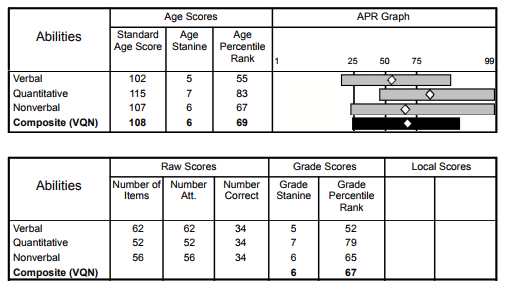CogAT scoring is based on your child’s age (not grade level). Your child will receive an SAS, or “Standard Age Score.” This score compares your child’s performance to peers of the same age. The highest SAS attainable on the CogAT is 160. In contrast, 100 represents an average score.
Here are all the steps for calculating a child’s unique test score:
- Raw Score. This total comprises the number of correct answers. Incorrect responses do not lead to deductions from the overall raw score.
- Universal Scale Score (USS). After determining the Raw Score, we convert it into a normalized standard score known as the Universal Scale Score. Additionally, separate USS scores exist for each test’s three verbal, nonverbal, and quantitative reasoning skills subsections, referred to as “batteries.” Consequently, we determine the Composite USS by averaging these three different scores. The USS is a normalized standard score that follows a consistent scale from kindergarten through 12th grade for the CogAT. Moreover, after determining a student’s raw score (the total number of questions answered correctly), we convert it to the USS. This conversion involves statistical procedures to ensure that variations do not influence scores in difficulty across different test forms. It’s important to note that USS scores are calculated for each test’s three batteries: verbal, nonverbal, and quantitative reasoning skills. This provides an evaluator with insight into a student’s strengths and weaknesses across different cognitive abilities.
- Standard Age Score (SAS). The Standard Age Score has a maximum possible score of 160; the average score is 100.
- Percentile Rank (PR). School districts use this number to compare students that share the same age and grade level. A percentile rank of 80 means that child’s score was higher than 80% of students who took the same test. The average percentile rank is 50.
- Stanine (S). A stanine is a very broad, simplified score ranging from 1 (lowest) to 9 (highest possible), and it’s normalized for the child’s age and grade level.


Understanding CogAT Scoring
The CogAT scores a student based on their raw score, which represents the total correct answers on the test. Subsequently, they convert this raw score into a scaled score, considering question difficulty, and report it on a scale ranging from 100 to 150. Additionally, scaled scores from the three batteries (verbal, quantitative, nonverbal) combine to form a composite score on the same 100 to 150 scale.
The CogAT is a norm-referenced test. This means scores are compared to those of students of the same age and grade, and percentile rank is used to report scores. It indicates the percentage of students who scored lower than the test-taker. For example, if a student has a percentile rank of 90, it means that they scored better than 90% of students who took the test.
Stanine and Percentile Ranking and Scoring for the CogAT
A range of percentile ranks comprises each stanine. The table below shows the percentile ranks that formulate each stanine and the associated ability level.
| Stanine | Percentile Rank | Description |
| 1 | 1 – 3 | This score is in the lowest 4%, signifying very limited cognitive abilities compared to peers. |
| 2 | 4 – 10 | This score is in the next 7%, still significantly below average and potentially struggling with CogAT cognitive tasks. |
| 3 | 11 – 22 | This score is in the next 12%, indicating below-average cognitive abilities in CogAT testing. |
| 4 | 23 – 39 | This score is in the next 17%, slightly below average but nearing the middle range. |
| 5 | 40 – 59 | This score is in the next 20%, placing students in the middle range with average cognitive abilities compared to peers. |
| 6 | 60 – 76 | This score is in the next 17%, indicating a slight cognitive ability above average in CogAT testing. |
| 7 | 77 – 88 | This score is in the next 12%, signifying above-average cognitive abilities in CogAT testing. |
| 8 | 89 – 95 | This score is in the next 7%, indicating well above-average cognitive abilities in CogAT testing. |
| 9 | 96 – 99 | This score is in the top 4%, signifying very high cognitive abilities compared to peers. |
Remember, they norm-reference these scores and percentiles by comparing an individual student’s performance to a larger sample of students. This method involves comparing a student’s performance to a representative sample. As such, they provide a way of understanding a student’s cognitive abilities relative to other students.
Want to try us out? Sign up for a free account today and get 100 gifted and talented practice questions.
